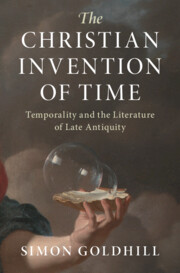Book contents
- The Christian Invention of Time
- Greek Culture in the Roman World
- The Christian Invention of Time
- Copyright page
- Contents
- Acknowledgements
- Abbreviations of Ancient Sources
- Introduction
- Part I
- Chapter 1 God’s Time
- Chapter 2 The Time of Death
- Chapter 3 Telling Time
- Chapter 4 Waiting
- Chapter 5 Time and Time Again
- Chapter 6 Making Time Visible
- Chapter 7 At the Same Time
- Chapter 8 Timelessness and the Now
- Chapter 9 Life-times
- Chapter 10 The Rape of Time
- Part II
- Coda
- Bibliography
- Index Locorum
- Subject Index
Chapter 8 - Timelessness and the Now
from Part I
Published online by Cambridge University Press: 13 January 2022
- The Christian Invention of Time
- Greek Culture in the Roman World
- The Christian Invention of Time
- Copyright page
- Contents
- Acknowledgements
- Abbreviations of Ancient Sources
- Introduction
- Part I
- Chapter 1 God’s Time
- Chapter 2 The Time of Death
- Chapter 3 Telling Time
- Chapter 4 Waiting
- Chapter 5 Time and Time Again
- Chapter 6 Making Time Visible
- Chapter 7 At the Same Time
- Chapter 8 Timelessness and the Now
- Chapter 9 Life-times
- Chapter 10 The Rape of Time
- Part II
- Coda
- Bibliography
- Index Locorum
- Subject Index
Summary
The messianic religions that came to dominate this lived life of late antiquity made waiting central to their sense of temporality, as we have seen. As the poets of erotics have always known, there is certain headiness in the combination of fervour and deferral. Waiting, however, structures the sense of the present – the now – with a question of its value, its temporariness. ‘Who would deny that the present has no duration?’, asked Augustine. In the nineteenth century, William James tried to answer this anxiety about the duration and thus evaluation of the ‘nowness’ of the now with an empirical, experimentally tested answer: ‘the practically cognized present is no knife-edge’, he concluded, ‘but a saddle-back, with a certain breadth of its own on which we sit perched and from which we look in two directions into time’. It was possible to count in seconds, and then in fractions of seconds, a human experience of now, a breadth measured ‘from one five-hundreth of a second to twelve seconds’.
- Type
- Chapter
- Information
- The Christian Invention of TimeTemporality and the Literature of Late Antiquity, pp. 156 - 180Publisher: Cambridge University PressPrint publication year: 2022

